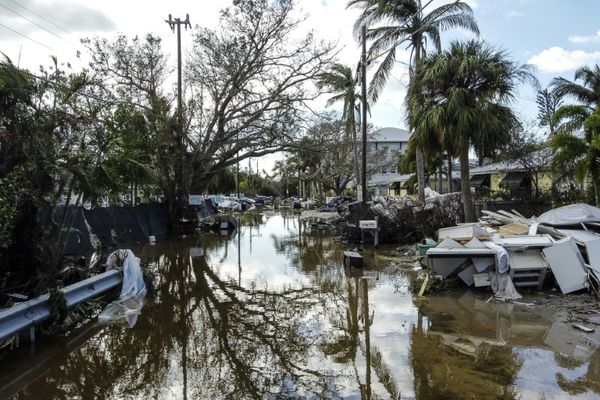
Nica Yusay has three vintage Gucci bags in her closet. One, a 1998 Tom Ford–era bag made entirely of Swarovski crystals that retails for about $15,000, she says she’ll keep forever.
But she’ll likely sell the rest via ShopFashioNica, the website she created for her vintage designer bag resale business that the 30-year-old calls her “pandemic baby.”
Yusay tells Fortune that she has been thrifting since she was 14, long before it became an internet trend beloved by Gen Z. What started as a cost-saving measure while she was growing up in a single-parent household in Southern California turned into a hobby when Yusay was in her early twenties, spending some of her corporate salary on secondhand designer bags. She started reselling some of them at the start of the pandemic, eventually quitting her digital marketing job in 2021 to turn the side hustle into a full-fledged business, which is projected to hit $4.5 million in sales by the end of this year, per documents Fortune viewed. (Yusay declined to say how much she earns, but CNBC reported at the end of 2021 that she had made $300,000 from the side hustle that year.)
When she was starting out, “I would probably sell like five bags a week,” she says. “But ever since I quit my corporate job to do this full-time, I probably sell 30 to 50 bags a week.”
Yusay is one of a new wave of resellers thriving in a skyrocketing resale market, the result of a perfect economic storm: Luxury brands scaled back production during COVID-19’s early days, even as demand grew among bored shoppers sitting on pandemic savings. Sizzling inflation and increased costs for raw materials, along with shipping delays and supply shortages, created scarcity. Reallocated discretionary income and an increased interest in sustainable fashion and thrifting only fueled the fire, Kelly McSweeney, women’s merchandising manager at luxury consignment marketplace The RealReal, tells Fortune. It all created a booming market for luxury handbag collectors like Yusay to sell in, either as an investment opportunity, business, or hobby.
The average retail price for women’s designer bags climbed from $1,944 in 2019 to $2,475 in 2022, according to Business of Fashion Insights. Bag prices at Louis Vuitton, Hermes, and Chanel hit a high in 2021 of more than 70% of the manufacturer's recommended retail price, according to the RealReal’s 2023 Luxury Consignment Report. “Consignors have earned more than ever,” McSweeney says.
View this interactive chart on Fortune.com
At the center of the trend are America’s Gen Z and millennials, some of whom have extra spending money while living with their parents, even while bringing home their first substantial paychecks.
The rise of the pandemic purse
The soaring popularity of designer bags is part of a bigger boom in luxury goods that started during the pandemic. Luxury spending in the U.S. was 47% higher in 2021 than it was in 2019, per Bank of America data, as more Americans splurged on designer items. It was almost counterintuitive, says Beth Goldstein, a fashion accessories analyst at NPD Group: Spending in a lot of clothing and accessories categories declined with people confined to their homes, she says, “but the designer space was an anomaly.”
Meanwhile, those sought-after bags became more scarce. Many high-end brands saw their leather factories in Italy shut down during COVID’s early days. They also halted production in an attempt to reduce their inventories, based on predictions that luxury spending would drop, says Claudia D’Arpizio, who leads the global fashion and luxury goods vertical at Bain & Co. In 2020, Bain forecasted that luxury market sales would fall by 35% that year, and brands, eager to prevent lockdown losses, began hiking the prices of some of their most iconic handbags. In 2021’s “hot vax summer” that never was, price increases became more frequent, with inflation only pushing them higher.
They’ve hardly stopped. In March of this year, Chanel instituted an 8% average increase across all of its bags, which Yusay calls “insanity.” The price increases catapulted the brand’s classic handbag over the $10,000 mark (the bag retailed for about $4,900 in 2015). Chanel—one of the top luxury brands that both luxury consignors and experts Fortune spoke with say consistently holds its value—has arguably been the most aggressive in its price hikes, but its competitors aren’t far behind. Louis Vuitton handbags cost 6% to 7% more worldwide, and Hermès announced plans last year to hike prices by 5% to 10% in 2023. Popular handbags in some markets have increased by as much as 25%, per a 2022 analysis by Bernstein Research.
And strikingly, these high prices didn’t tamp down demand, says D’Arpizio. “During COVID and immediately after COVID, consumers really digested the price increases super well,” she says, explaining that this opened up the door for brands to cater to new, aspirational, younger customers who weren’t necessarily looking for a bargain on the secondhand market. “So there was a market that was happy to pay two times or three times the price of the primary market to get these bags,” she says.
Some of the consumers are also hobbyist resellers, like Emily Dao, a 28-year-old luxury content creator. Similar to Yusay, she treated herself to her first luxury bag (a Gucci Soho Disco crossbody) when she got her first “big girl job” as a teacher at a private school, she says. (She was also bringing in income from her YouTube videos.) Dao typically buys bags twice a year, doing a lot of research to gauge resale value before she makes a purchase. If she hasn’t used a bag in six months, she’ll sell it. She says the highest profit she has made is $1,000. When she makes a profit, she typically saves it for her next purchase or invests some of it.

On the luxury consignment site the RealReal, handbag demand among Gen Zers is up by 136% since 2019, while demand among both millennials and Gen X is up by 78%, according to The RealReal’s 2022 Luxury Resale Report. The site found that Gen X resells the most and Gen Z resells the fastest. But like many, Dao sells via an Instagram account. Others sell their luxury wares on one of the many Facebook groups dedicated to high-end designers, from Chanel to Hermès, also known as Reetzy Community and Marketplace.
Many resellers Fortune spoke with say they prefer these kinds of social media avenues so they can avoid the commission fees charged by third-party platforms such as the RealReal, Depop, and Poshmark. Plus, it feels more personal and for some can be a way to engage with followers. “It’s really cool to know my bag is going to someone who has seen it from the moment I’ve unboxed it and styled it a few times,” Dao says.
Flipping bags for years to come
Despite economic uncertainty, the future of the global designer handbag market remains bright as more women around the world prioritize their careers and bring home a salary that allows them to afford such bags. The industry is expected to grow from $72 billion in value to $100 billion in 2026, per a July 2022 study from the Business of Fashion. Plus, Gen Z teens are already splurging—and they are set to become the biggest buyers of luxury goods by 2030.
But resale value has begun to level out, with price drops from 2022 to 2023 varying from 6% to 8% on the RealReal, depending on the brand. (Prices remain higher than pre-pandemic, however.) Consumers are shifting to more affordable, trendier styles like Bottega Veneta instead of ultra-luxury classics.
Amanda, a 33-year-old hobbyist reseller who did not want her last name used to protect her privacy, says she has noticed this shift in the resale market, as inflation remains stubborn despite cooling some, and many Americans worry over an impending recession. Amanda says she flips about 25 to 40 handbags a year.
At one point, Amanda saw some eye-popping profits—in spring of 2021, for example, she sold a single Chanel bag for a $2,000 profit, she recalls. But lately she has seen those in-demand Chanel bags on the resale market for about $1,000 to $1,500 less than the $10,000 they were selling for last year.
Indeed, while there’s still a desire for the most coveted brands, there is a bit of softness creeping into the U.S. in “the belly of the market,” D’Arpizio says. “The effects of the hyperinflation on discretionary spending now that people are turning back to normal life, including traveling and all these experiences, is reducing [prices] for sure,” she says. But the top of the pyramid—the super wealthy—are still going strong.
For those contemplating getting into the business of buying and selling luxury bags, Amanda recommends avoiding flashy or trendy bags unless they’re limited editions. In the era of quiet luxury, in which the ultrawealthy prefer to signal their status with understated pieces instead of flashy logos, monogrammed bags haven’t been selling as well as they used to, she notes.
As for Yusay, she recommends never buying a bag that you wouldn’t personally carry. “If I wouldn't wear it myself, I'm not going to source it, because that's a risk,” she says. “If it doesn't sell, then I'm stuck with a bag.”







